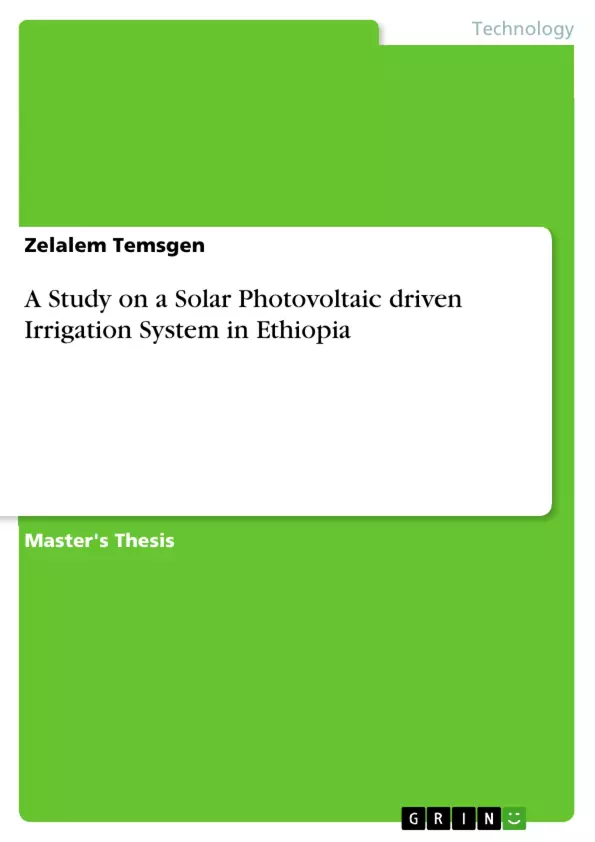This study presents the design and simulation of a solar PV driven irrigation system to irrigate 10-hectare farm located at Ethiopia, Debre Markos, Wonka site. The design phase was considered based on the parameters such as pump power rating, solar PV sizing, running hours, designing and selecting an inverter. The sizing process starts with collecting data and determining correct estimation of water needs in the targeted site. The system can provide a daily average of 41 m3 of water for irrigation. Considering one cloudy day, the system is designed to pump 82 m3 water/day. Batteries are not considered because they reduce the overall efficiency of the system and increase all over maintenance and investment cost. Instead of storing electricity in batteries, Circular water storage tank was designed to store 82 m3 water for two days application. The system consists of solar array, boost converter, three-phase inverter and 3.3-kW rating induction motor along with a centrifugal pump. Based on the motor rating, the solar panel rating is decided to be 7.6 kW considering losses in the system.
Inhaltsverzeichnis (Table of Contents)
- CHAPTER 1- INTRODUCTION
- 1.1 Renewable and Solar Energy
- 1.2 Energy and Irrigation in Ethiopia
- 1.3 Research Review
- 1.4 Statement of problem
- 1.5 Main Objective of This Study
- 1.6 Significance of Study
- 1.7 Proposed System Overview
- 1.8 Scope of Work
- 1.9 Dissertation Layout
- CHAPTER 2- SOLAR PV DRIVEN IRRIGATION SYSTEM
- 2.1 Rural Electricity in Ethiopia
- 2.2 Principles of Solar PV Powered Irrigation Technology
- 2.3 Solar PV Pumping Configurations
- 2.3.1 Direct Coupled Solar Driven Irrigation System
- 2.3.2 Battery Coupled Solar Driven Irrigation system
- 2.4 Proposed System
- 2.4.1 Physical Model of Proposed system
- 2.5 Photovoltaic (PV) Power System Components
- 2.5.1 Photovoltaic Array Structure
- 2.5.2 Power Conversion and Control System
- 2.5.3 Method of Irrigation System
- 2.5.4 Sprinkler Irrigation
- CHAPTER 3- SYSTEM SIZING AND DESIGNING METHODOLOGY
- 3.1 Methodology
- 3.2 System Sizing
- 3.2.1 Study Site
- 3.2.2 Data collection
- 3.2.3 Determining required water
- 3.2.4 Water storage design
- 3.2.5 Solar Insolation
- 3.2.6 Pump Flow Rate
- 3.2.7 Total Dynamic Head
- 3.2.8 Motor and Pump
- 3.2.9 Sizing and Selecting of Solar PV Module
- 3.2.10 Sizing of Inverter
- CHAPTER 4- SYSTEM MODELING IN SIMULINK
- 4.1 Modelling Solar PV
- 4.2 DC-DC Boost Converter Modeling
- 4.3 Modeling Maximum Power Point tracking
- 4.4 Invertor Modeling Using Simulink
- 4.4.1 LC Filter
- 4.5 Modeling Induction Motor
- 4.6 Modeling Centrifugal Pump
- 4.7 Mathematical Modeling Storage Tank
- 4.7.1 Tank Control
- 4.8 Complete Model of Solar Driven Irrigation System
- CHAPTER 5- SIMULATION RESULT AND DISCUSSION
- 5.1 Result and Analysis
- 5.1.1 Solar Array Output Power and Voltage
- 5.1.2 Effect of Solar radiation on the output Power
- 5.1.3 DC-DC Boost converter Output Voltage
- 5.1.4 Three-Phase Voltage Source Inverter Simulation Result
- 5.1.5 Induction Motor Simulation Result
- 5.1.6 Water Flow Output Result
- CHAPTER 6- ECONOMIC AND ENVIRONMENTAL ANALYSIS
- 6.1 Economic and Environmental Analysis of the System
- 6.2 Solar PV Driven Irrigation System
- 6.2.1 Diesel Systems
- 6.3 Life Cycle Operating Cost Analysis
- 6.3.1 Cost-Benefit analysis
- 6.4 Socio-Economic Advantage
- 6.5 Environmental analysis
Zielsetzung und Themenschwerpunkte (Objectives and Key Themes)
This dissertation aims to design and simulate a solar photovoltaic (PV) driven irrigation system for a 10-hectare farm in Debre Markos, Ethiopia, addressing the challenges of seasonal rain-based farming and lack of electricity access. The study evaluates the system's economic and environmental feasibility compared to diesel-powered alternatives.
- Design and simulation of a solar PV driven irrigation system.
- Economic analysis of the solar PV system versus diesel alternatives.
- Environmental impact assessment, focusing on CO2 emission reduction.
- System modeling and simulation using MATLAB/Simulink and other software.
- Feasibility study of solar PV irrigation in a specific Ethiopian context.
Zusammenfassung der Kapitel (Chapter Summaries)
Chapter 1 introduces the context of renewable energy and irrigation in Ethiopia, outlining the research problem and objectives. Chapter 2 details the proposed solar PV driven irrigation system, including its components and configuration. Chapter 3 describes the methodology for system sizing and design, including data collection and parameter calculations. Chapter 4 explains the system modeling process in MATLAB/Simulink, covering various subsystems. Chapter 5 presents the simulation results and analysis of the system's performance. Chapter 6 analyzes the economic and environmental aspects of the proposed system, comparing it to diesel-powered systems.
Schlüsselwörter (Keywords)
Solar PV driven irrigation, Ethiopia, rural electrification, economic analysis, environmental impact, CO2 emission reduction, system simulation, MATLAB/Simulink, renewable energy, sustainable agriculture, poverty alleviation.
- Quote paper
- Zelalem Temsgen (Author), 2020, A Study on a Solar Photovoltaic driven Irrigation System in Ethiopia, Munich, GRIN Verlag, https://www.grin.com/document/1503619



